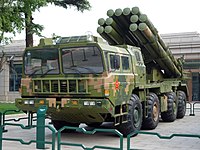People's Liberation Army Ground Force
This article needs additional citations for verification. (April 2020) |
| People's Liberation Army Ground Force | |
|---|---|
| 中国人民解放军陆军 | |
 Emblem of the People's Liberation Army Ground Force | |
| Founded | 1927 |
| Country | |
| Allegiance | |
| Type | Army |
| Role | Land warfare |
| Size | 975,000 active (est.) as of 2020 [1] |
| Part of | |
| March | Military Anthem of the People's Liberation Army |
| Aircraft | 1,050[2] |
| Engagements | World War II (1937-45) Chinese Civil War (1927, 1946) Korean War (1950-53) Sino-Indian War (1962) Sino-Soviet border conflict (1969) Vietnam War (1962-75) Nathu La and Cho La clashes(1967) Sino-Vietnamese War (1979) Sino-Vietnamese conflicts 1979-90 (1979-90) 1999 East Timorese crisis Northern Mali conflict (2012- ) South Sudanese Civil War (2013-20) 2020–2021 China–India skirmishes (2020- ) [3] |
| Website | www |
| Commanders | |
| Commander | General Han Weiguo |
| Political Commissar | General Liu Lei |
| Insignia | |
| Symbol |  |
| Flag | 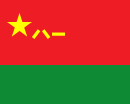 |
| Aircraft flown | |
| Attack helicopter | CAIC Z-10, Changhe Z-11, Harbin Z-19, |
| Cargo helicopter | Aérospatiale SA 321 Super Frelon, Changhe Z-18, Harbin Z-9 |
| Observation helicopter | Changhe Z-11, Harbin Z-19 |
| Trainer helicopter | Eurocopter AS350 Écureuil, Eurocopter EC120 Colibri |
| Transport | Shaanxi Y-8, Shaanxi Y-9, Xian Y-7 |
The People's Liberation Army Ground Force (PLAGF) (Chinese: 中国人民解放军陆军; pinyin: Zhōngguó Rénmín Jiěfàngjūn Lùjūn) is the land-based service branch of the People's Liberation Army and the largest and oldest branch of the entire Chinese armed forces. The PLAGF can trace its lineage from 1927 as the Chinese Red Army; however, it was not officially established until 1948.
History[]
In February 1949 the existing large number of armies and divisions were regularised into up to seventy armies of three divisions each. While some, such as the 1st Army, survived for over fifty years, a number were quickly amalgamated and disestablished in the early 1950s. It appears that twenty per cent or even more of the seventy new armies were disestablished up to 1953; in 1952 alone, the 3rd, , , 17th, 18th, and Armies were disbanded.[4]
The PLA ground forces consist of conventionally armed main and regional units, which in 1987 made up over 70 percent of the PLA. It provided a good conventional defense, but in 1987 had only limited offensive potential and was poorly equipped for nuclear, biological, or chemical warfare. Main forces included about 35 group armies, comprising 118 infantry divisions, 13 armored divisions, and 33 artillery and antiaircraft artillery divisions, plus 71 independent regiments and 21 independent battalions of mostly support troops.[5] Regional forces consisted of 73 divisions of border defense and garrison troops plus 140 independent regiments.
Under the old system, a field army consisted of three partially motorized infantry divisions and two regiments of artillery and anti-aircraft artillery.[5] Each field army division had over 12,000 personnel in three infantry regiments, one artillery regiment, one armored regiment, and one anti-aircraft artillery battalion. Organization was flexible, the higher echelons being free to tailor forces for combat around any number of infantry divisions. At least theoretically, each division had its own armor and artillery — actual equipment levels were not revealed and probably varied — and the assets at army level and within the independent units could be apportioned as needed.
In 1987 the new, main-force group armies typically included 46,300 soldiers in up to four divisions, believed to include infantry, armor, artillery, air defense, airborne, and air support elements.[5] Although the new group armies were supposed to reflect a move to combined-arms operations, because of a lack of mechanization they continued to consist of infantry supported by armor, artillery, and other units. The 13 armored divisions each had 3 regiments and 240 main battle tanks (MBT) but lacked adequate mechanized infantry support. There was little evidence of the use of armored personnel carriers during the Sino-Vietnamese border conflict in 1979, and tanks were used as mobile artillery and as support for dismounted infantry. Artillery forces emphasized towed guns, howitzers, and truck-mounted multiple rocket launchers. In the 1980s some self-propelled artillery entered service, but the PLA also produced rocket launchers as a cheaper but not totally effective alternative to self-propelled guns. There was a variety of construction equipment, mobile bridging, trucks, and prime movers. A new multiple rocket launcher for scattering antitank mines appeared in 1979, but mine-laying and mine-clearing equipment remained scarce.
Regional forces consisted of full-time PLA troops organized as independent divisions for garrison missions.[5] Garrison divisions were static, artillery-heavy units deployed along the coastline and borders in areas of likely attack. Regional forces were armed less heavily than their main-force counterparts, and they were involved in training the militia. They were the PLA units commonly used to restore order during the Cultural Revolution. When chairman Mao proclaimed the People's Republic of China on October 1, 1949, PLA ground force was 4.9 million-strong peasant army. After some time, demobilization of ill-trained and politically unreliable troops began, resulting in the reduction of army strength.
In the 21st century, the PLA Ground Forces are continuing to undergo significant reform, experimentation, modernization and re-structuring to deal with potential threats and enhance their capabilities. Divisions are downsized into combined arms brigades, which reorganized into high-readiness army groups. The division echelon iisphased out with only a limited number of division structures remain existent.[6] While the size of the PLA Ground Force has been reduced over the past few decades, technology-intensive elements such as special operations forces (SOF), army aviation (helicopters), surface-to-air missiles (SAMs), and electronic warfare units have all been rapidly expanded. The latest operational doctrine of the PLA ground forces highlights the importance of information technology, electronic and information warfare, and long-range precision strikes in future warfare. The older generation telephone/radio-based command, control, and communications (C3) systems are being replaced by an integrated battlefield information networks featuring local/wide-area networks (LAN/WAN), satellite communications, unmanned aerial vehicle (UAV)-based surveillance and reconnaissance systems, and mobile command and control centers.[7][better source needed]
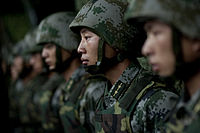
Soldiers of the People's Liberation Army Ground Force in 2011
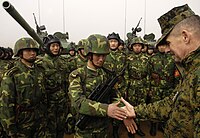
Chairman of the Joint Chiefs of Staff Peter Pace shakes hands with Chinese tankers at Shenyang in 2007

PLAGF and Oregon National Guard work alongside during a disaster response exercise in 2017
Structure[]
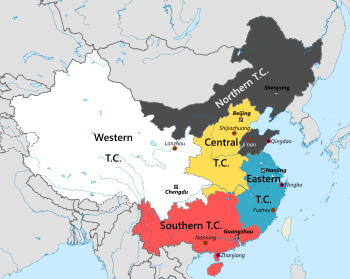

Branches of service[]
The People's Liberation Army Ground Force has standing regular army and reserve force. Although conscription is employed in China by law, mandatory military service has not been implemented since 1949 as the People's Liberation Army has been able to recruit sufficient numbers voluntarily.[8] Chinese militia is not a component of the People's Liberation Army, however they could provide a certain degree of reserve function, which was indicated by "Militia Military Training and Evaluation Outline" released by the People's Liberation Army General Staff Department in 2007.[9]
PLAGF branches of service (Chinese: 兵种; pinyin: Bīngzhǒng) are composed of infantry (including mechanized infantry), tanker, artillery, aviation, military engineering, anti-chemical (nuclear, biological and chemical defense), signaller, special operation, reconnaissance, electronic warfare, etc. These branches of service have their respective military education institutions.[10]
Operational structure[]
PLA operational structure reflects China's strategic missions, political environment, and geographical circumstances.[11] There are 13 corps sized group armies (Chinese: 集团军; pinyin: Jítuánjūn) since the end of April 2017, divided among five Theater commands — Eastern, Southern, Northern, Western and Central. Within the group armies, the old divisions (Chinese: 师; pinyin: Shī) are being downsized into brigades (Chinese: 旅; pinyin: Lǚ). Each group army includes six maneuver combined arms brigades, fire support/artillery brigades, air defense brigades, aviation brigades, special operations brigades, combat support brigades, and sustainment brigades. Maneuver combat component of the group armies are combined arms brigades (Chinese: 合成旅; pinyin: Héchénglǚ), including a mix of heavy combined arms brigades, medium combined arms brigades, light combined arms brigade, amphibious combined arms brigades, and mountain combined arms brigades. The practice is functionally similar to the US Army brigade combat team concept with unique modifications influenced by China's terrain diversity, strategic priority, political system, and military history.[11][12][13]
The PLA heavy, medium, and light combined arms brigades share similar modular construct, which resembles its superior and subordinate units at group army and battalion level. A typical PLAGF combined arms brigade has the brigade HQ, four maneuver combat battalions, and other support battalions. For instance, a heavy combined arms brigade includes four combined arms battalions (Chinese: 合成营; pinyin: Héchéngyíng), one artillery battalion, one air defense battalion, one reconnaissance battalion, one combat support battalion, and one sustainment battalion.[12][13] Combined arms battalions apply a structure drawn from the brigade echelon. For example, heavy combined arms battalions consist of battalions HQ company (including subordinate medic, reconnaissance, and air defense platoons),[14][15] four maneuver combat companies including two tank companies (14 tanks per company), and two mechanized infantry companies (14 vehicles per company),[16] one firepower company, and one combat support/sustainment company.[17]
Before the 2015 reform, the International Institute for Strategic Studies (IISS) attributes the PLA Ground Force with nine active armored divisions consisting of a number of armored brigades, 25 infantry divisions (mechanized or motorized), organized into a number of infantry brigades, and 8 artillery divisions, also organized into field artillery brigades. Dennis Blasko wrote in 2000[18] that the traditional structure of PLA divisions (armored and mechanized) consisted roughly of three regiments – tuan (Chinese: 团; pinyin: Tuán) (later on brigades) – of the main service arm, each of three battalions (Chinese: 营; pinyin: yíng) plus support units, a fourth regiment/brigade of infantry (in an armored division) or armor (in an infantry division), a field artillery regiment, an anti-aircraft defense regiment or battalion, and signals, engineer, reconnaissance, and chemical defense battalions or companies, plus combat service support units.[citation needed]
In the 1980s, regional forces consisted of full-time PLA troops organized as independent divisions for garrison missions. An example of such a formation was the 1st Garrison Division of Lanzhou Military Region. Garrison divisions were static, artillery-heavy units deployed along the coastline and borders in areas of likely attack. Regional forces were armed less heavily than their main-force counterparts, and they were involved in training the militia. They were the PLA units commonly used to restore order during the Cultural Revolution.[citation needed]
Special operations forces[]
The PLA first became interested in modern special warfare in the mid-1980s when it was shifting from the "People's War" to "active defense."[11] The PLA planners believed that the next war would be a short, fast-pace conflict on the periphery rather than a total war on Chinese territories, and conventional infantry-orientated ground forces in their mass numbers could no longer meet the requirements. It specialises in rapid reaction combat in a limited regional war under high-tech conditions, commando operations, counter-terrorism, and intelligence gathering. The size of the Special Operations Forces is estimated at 7,000 ~ 14,000 troops.[citation needed] Currently, PLA special operations forces are organized under the combined corps level, as special operations brigades (Chinese: 特战旅; pinyin: Tèzhànlǚ).[19]

U.S. Defense Secretary Robert Gates greets Chinese Defense Minister Cao Gangchuan in Beijing, China on 5 November 2007

Military guard of the PLAGF in 2012

PLAGF infantrymen at the 2015 China Victory Day Parade
Personnel[]
Commissioned officers[]
The current system of officer ranks and insignia is established in 1988. There are several paths to becoming a commissioned officer, such as joining a military academy, attending reserve officer program, or cadre selection program.[20]
Officers may use Comrade to formally address another member of the military ("comrade" plus rank or position, as in "comrade Colonel", "comrade battalion leader", or simply "comrade(s)" when lacking information about the person's rank, or talking to several service people.)[21]
| Title | 上将 Shang Jiang |
中将 Zhong Jiang |
少将 Shao Jiang |
大校 Da Xiao |
上校 Shang Xiao |
中校 Zhong Xiao |
少校 Shao Xiao |
上尉 Shang Wei |
中尉 Zhong Wei |
少尉 Shao Wei |
学员 Xue Yuan |
|---|---|---|---|---|---|---|---|---|---|---|---|
| Equivalent translation | General | Lieutenant general | Major general | Senior colonel | Colonel | Lieutenant colonel | Major | Captain | 1st lieutenant | 2nd lieutenant | Officer cadet |
| (OF-9) | (OF-8) | (OF-7) | (OF-6) | (OF-5) | (OF-4) | (OF-3) | (OF-2) | (OF-1) | (OF-D) | ||
| Shoulder insignia | 
|

|

|

|

|

|

|

|

|

|

|
| Collar insignia | 
|

|

|

|

|

|

|

|

|

|

|
Enlisted personnel[]
The current system of other ranks and insignia dates from 2009.[22] Sergeant and Corporal are referred to as non-commissioned officers. New recruits have no military ranks before the boot camp is completed, and they will be awarded the rank of private after they have graduated from the induction training.[23] According to Article 16 of Chapter 3 of the "Regulations on the Service of Active Soldiers of the Chinese People's Liberation Army" (Chinese: 中国人民解放军现役士兵服役条例), "The lowest enlisted rank is Private".[23] Conscripts can be promoted to privates first class in their second year. At the end of two years, conscripts may retire or become NCOs if they volunteer, though the position requires at least high school diploma, specialized skills, or undertaking training courses.[24] They can also attend a military academy to become officers after evaluations.[20] In 2014, the position of unit "master chief" or "sergeant major" is established to award experienced NCOs that can assist platoon, company, battalion, and higher commands in leadership and training responsibilities.[20]
Soldiers may use Comrade to formally address another member of the military ("comrade" plus rank or position, as in "comrade Sergeant", "comrade squad leader", or simply "comrade(s)" when lacking information about the person's rank, or talking to several service people.)[21]
| Title | 一级军士长 Yi ji jun shi zhang |
二级军士长 Er ji jun shi zhang |
三级军士长 San ji jun shi zhang |
四级军士长 Si ji jun shi zhang |
上士 Shang shi |
中士 Zhong shi |
下士 Xia shi |
上等兵 Shang deng bing |
列兵 Lie bing |
|---|---|---|---|---|---|---|---|---|---|
| Equivalent translation | Master sergeant class one | Master sergeant class two | Master sergeant class three | Master sergeant class four | Staff Sergeant | Sergeant | Corporal | Private 1st class | Private |
| (OR-9) | (OR-8) | (OR-7) | (OR-6) | (OR-5) | (OR-4) | (OR-3) | (OR-2) | (OR-1) | |
| Shoulder insignia | 
|

|

|

|

|

|

|

|

|
| Collar insignia | 
|

|

|

|

|

|

|

|

|
Equipment[]
Heavy equipment[]
PLA Ground Force is largely mechanized with armored platforms, advanced electronic warfare capability, and modern weapon systems that are competitive against Western counterparts.[19] PLA ground force is divided into highly mechanized heavy, medium, and light combined arms forces. Heavy combined arms brigades are armored with main battle tanks and tracked infantry fighting vehicles, medium combined arms brigades are armed with tracked or wheeled infantry fighting vehicles, and light combined arms brigades are mobilized with armored personal carriers, MRAP trucks, or armored cars.[6] At combined corps levels, PLAGF employs combined arms brigades, heavy artillery systems, medium-range air defense systems, special forces, army aviation units, and various engineering, electronic warfare support systems. Weapon systems at this level include PLZ-05 howitzer, PCL-181 howitzer, PHL-03/16 multiple rocket launcher, AFT-10 missile carrier, and HQ-16 air defense system.[25] Air assets within the aviation brigade include Z-10 attack helicopter, Z-19 recon helicopter, and Z-20 utility helicopter, etc. At combined arms brigade level, brigade HQ can deploy various combined arms battalions composited with tanks, assault guns, and infantry fight vehicles (IFV) such as ZTZ-99A tank, ZBD-04A IFV, ZBL-08 IFV, ZTL-11 assault gun, and CSK-181 MRAP fast-attack vehicle. Fire support, reconnaissance and air defense battalion are equipped with self-propelled artilleries, rocket launchers, missile carriers, unmanned aerial vehicles, and air defense systems such as PLZ-07, PLL-09, PCL-161/171, PHL-11, PHZ-11, PGZ-09/95, AFT-9/10, PGL-AA and HQ-17/A.[19][26]
At battalion level, battalion HQ can direct tank company, assault gun company, mechanized infantry company, and firepower company (Chinese: 火力连; pinyin: Huǒlìlián) to provide rapid close-combat maneuver, with equipment including PCP001 rapid-firing mortar, PLL-05/PLZ-10 self-propelled gun-mortar, AFT-8 missile carrier, MANPADS, and crew-served weapon systems such as QJG-85 heavy machine gun, PP-87 mortar, QLZ-04 automatic grenade launcher, and HJ-8E wire-guided missile.[11][16] Under each mechanized infantry company is standard infantry platoons and a firepower platoon (Chinese: 火力排; pinyin: Huǒlìpái), which is equipped with lightweight mortar, anti-material rifle, 35 mm automatic grenade launcher, rocket launcher, and heavy machine gun.[15][27] At company and platoon level, a mechanized infantry squad consists of nine infantrymen, in which seven members are dismounted during combat. Infantry squad varies in composition based on the type of combined arms battalions. Medium and light infantry squad equips reusable rocket launchers to improve anti-armor and anti-fortification capability, whereas heavy infantry squad has no squad-level rockets, instead relies on fire support from the firepower platoon, or their own ZBD-04A infantry fighting vehicle.[19]
Weapons[]
Individual and crew-served weapons[]
The standard issue rifle of PLA infantrymen is QBZ-95/191 chambered in proprietary 5.8×42mm, and the sidearm is QSZ-92 chambered in 5.8×21mm DAP92. Vehicle crew is equipped with QBZ-95B short-barreled carbine. The QCW-05 is a 5.8 mm submachine gun used by special forces and non-combat personnel. Sharpshooting is provided by the QBU-88/191 marksman rifle and QBU-141/202 sniper rifle. Indirect fire is provided by the QLG-10 grenade launcher. QBS-09 combat shotgun is issued for door breaching and close-quarters battle. The QJB-95 serves as the squad automatic weapon with its 75-round drum magazine.[28] PF-89, , and DZJ-08 disposable rocket launchers could be distributed at ad hoc basis to infantry squads for direct-fire applications. Specialized fire support weapons, often equipped with dedicated rocketeers, or members of the firepower platoons, include the HJ-12 anti-tank guided missile,[29][30] PF-98 rocket launcher, the QLZ-87 and QLZ-04 35 mm automatic grenade launcher, the QBU-10 anti-material rifle, QLU-11 sniper grenade launcher, QJG-02 anti-air machine gun, QJZ-89 heavy machine gun, and the PP-89 60 mm mortar. The larger caliber PP-87 82 mm mortar is fielded at the battalion level's firepower company.[27]
Infantry equipment and uniforms[]
In 2014, the cost to equip a single Chinese soldier is about 9,400 yuan (US$1,523). The standard kit includes Type 07 camouflage uniforms, helmet, tactical vest, gas mask, backpack, first-aid kit, infantry weapons, woven belt, rain cap, camouflaged uniform, kettle, and combat boots. However, regular infantrymen rarely use the issued body armor stored in the armory.[31][32] Prior to 2015, only special operation detachment and soldiers in the active mission were equipped with body armor.[33] The infantry equipment such as heavy body armor, personal radio, knee pads has been seen in the standard kit in 2015 when PLA are deployed into high-risk areas, as observed for units participating in UN Peacekeeping and counter-piracy operations.[34] PLA has started to procure body armors for soldiers on large scale since March 2020, with 1.4 million body armor on order, which includes 930,000 units of plates for universal bulletproof vests and 467,000 units of plates for an enhanced bulletproof vest.[35] Type 19 uniform with new xingkong digital camouflage patterns, tactical vest, backpack, protective gear, and eyewear started to replace Type 07 uniform series since 2019.[36][37] Along with the uniform, new communication system, personal computer, tactical interface, and assault rifle family QBZ-191 are also being adopted by the PLAGF since 2019. These new upgrades are components of the new Integrated Soldier Combat System, a program aiming to overhaul the PLA's infantry equipment.[38]
Transformation[]
In 1987 the PLA ground forces, which relied upon obsolescent but serviceable equipment, were most anxious to improve defenses against armored vehicles and aircraft.[5] Most equipment was produced from Soviet designs of the 1950s, but weapons were being incrementally upgraded, some with Western technology. One example of upgraded, Soviet-design equipment was the Type 69 MBT, an improved version of the Type 59 MBT, itself based on the Soviet T-54. The Type 69 had improved armor, a gun stabilizer, a fire control system including a laser rangefinder, infrared searchlights, and a 105 mm smooth-bore gun. In 1987 the existence of a new, Type 80 MBT was revealed in the Western press. The tank had a new chassis, a 105 mm gun, and a fire control system. The PLA was believed to have atomic demolition munitions, and there were unconfirmed reports that it also had tactical nuclear weapons. In any case, nuclear bombs and missiles in the Chinese inventory could be used in a theater role. The PLA had a scarcity of antitank guided missiles, tactical surface-to-air missiles, and electronics to improve communications, fire control, and sensors. China began production of the Soviet Sagger antitank missile in 1979 but lacked a more powerful, longer range, semiautomatic antitank guided missile. The PLA required a mobile surface-to-air missile and an infantry shoulder-fired missile for use against helicopters and certain other aircraft.[citation needed]
The PLA Ground Forces continue to undergo significant modernization and re-structuring to deal with potential threats and enhance their capabilities.[6] Front line troops such as special forces, marines and paratroopers are given priority in receiving modern weapon systems and equipment. Other areas of improvement are its battlefield C4ISR capabilities, with the introduction of satellite communications, wireless networks, and digital radios, army commanders are now able to maintain constant communications with their front-line units while on the move. The bulk of the ground forces have been regularly asked to operate under severe electronic countermeasures conditions in exercises. Also a network-centric warfare capability connecting different combat, intelligence, surveillance and reconnaissance elements to form an integrated network is being developed.[39][better source needed]
Equipment Summary[]
The PLAGF inventory maintains an array of military vehicles. All figures below are provided by the International Institute for Strategic Studies. Auxiliary vehicles such as engineering vehicles, logistics vehicles, reconnaissance vehicles, as well as antiquated and reserved equipment are not included.[40]
| Type | Active | Description |
|---|---|---|
| Main battle tanks | 5,650 | [40] |
| Light tanks and assault guns | 1,450 | e.g. ZTQ-15 and ZTL-11[40] |
| Amphibious fighting vehicles | 950 | e.g. ZTD-05 and ZBD-05[40] |
| Infantry fighting vehicles | 6,700 | [40] |
| Armored personnel carriers | 3,950 | [40] |
| Anti-tank missile carriers | 1,230 | [40] |
| Towed artillery | 1,234 | [40] |
| Self-propelled artillery | 3,600 | [40] |
| Anti-air artillery | 7,396 | [40] |
| Surface-to-air missile systems | 1,531 | excluding MANPADS[40] |
| Multiple rocket launch systems | 1,770 | [40] |
| Helicopters | 1,243 | [40] |

Type 99A main battle tank
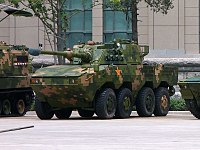
Type 11 Assault Vehicle
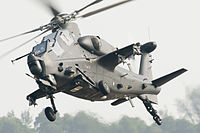
CAIC Z-10

Infantrymen with QBZ-95
Relationship with other organizations[]

The People's Liberation Army Ground Force maintains close relationships with several paramilitary organizations within China, primarily the People's Armed Police (PAP) and the Militia (also known as the China Militia). Both of these paramilitary organisations act as a reserve force for the PLAGF during a time of national emergency such as war or natural disaster. The PAP consists of approximately 1.5 million personnel. Their primary mission during peacetime is internal security and counter-terrorism.[41][42] The Militia is a mass force engaged in daily production under the leadership of the Communist Party of China (CPC), and forms part of the Chinese armed forces. Under the command of the military organs, it undertakes such jobs as war preparation services, security and defense operation tasks and assistance in maintaining social order and public security. The Militia numbers some 3 million service men and women.[43][44]
See also[]
- Ranks of the People's Liberation Army Ground Force
- People's Armed Police
- Militia (China)
- Republic of China (Taiwan) Army
References[]
Citations[]
- ^ "India vs China: Indian Army and People's Liberation Army Ground Force (PLAGF) compared". Army Technology. Verdict Media Limited. September 18, 2020. Retrieved February 19, 2021.
- ^ International Institute for Strategic Studies: The Military Balance 2018, p. 251.
- ^ "Chinese army soldiers conduct first mission as peacekeepers in Mali 1612131 - Army Recognition". Armyrecognition.com. Retrieved 2014-02-11.
- ^ "陆军军史:中国解放军第三军". www.360doc.com. Archived from the original on 2018-03-10. Retrieved 2017-07-21.
- ^ Jump up to: a b c d e Warden, Robert L.; Savada, Andrea; Dolan, Ronald; Library of Congress, Federal Research Division (1988). "China: A Country Study". pp. 582–3. Retrieved 2017-07-21.CS1 maint: multiple names: authors list (link)
- ^ Jump up to: a b c A. Marvel, Bradley (September 2019). "The Combined Arms Battalion and Combined Arms Brigade: The New Backbone of the Chinese Army". Red Diamond. 10 (3): 30. Retrieved 11 May 2021.
- ^ "Chinese Ground Forces". SinoDefence.com. Archived from the original on 2013-11-04. Retrieved 2010-02-12.
- ^ Kang Shi-ren (康世人) (2015-04-02). "解放軍地位高 農夫搶當兵(The soldiers of PLA are respected, peasants are scrambling to join the army". (臺灣)中央社(Central Agent (Taiwan)). Archived from the original on 2017-02-03.
- ^ L. Garcia, Richard (September 2019). "China's Maritime Militia". Red Diamond. 10 (3): 11. Retrieved 13 May 2021.
- ^ Heaton, William R (1980). "Professional Military Education in China: A Visit to the Military Academy of the People's Liberation Army". The China Quarterly. 81 (122): 122–128. doi:10.1017/S0305741000012182. JSTOR 652806.
- ^ Jump up to: a b c d A. Marvel, Bradley (September 2019). "The Combined Arms Battalion and Combined Arms Brigade: The New Backbone of the Chinese Army". Red Diamond. 10 (3): 46. Retrieved 11 May 2021.
- ^ Jump up to: a b Arostegui, Joshua (2020). "An Introduction to China's High-Mobility Combined Arms Battalion Concept" (PDF). U.S Army.
- ^ Jump up to: a b "Learning from Russia: How China used Russian models and experiences to modernize the PLA". Mercator Institute for China Studies. 23 September 2020.
- ^ "陆军调整转型方向之一的"合成营"练得如何了?". Guancha (in Chinese).
- ^ Jump up to: a b "军改-15:升级版合成营(下)". 94477 (in Chinese).
- ^ Jump up to: a b "军改-14 升级版合成营 (上)". 94477 (in Chinese).
- ^ A. Marvel, Bradley (September 2019). "The Combined Arms Battalion and Combined Arms Brigade: The New Backbone of the Chinese Army". Red Diamond. 10 (3): 27. Retrieved 11 May 2021.
- ^ Chapter 8, PLA Ground Forces, by Dennis J Blasko, in The People's Liberation Army as Organisation, RAND, CF182
- ^ Jump up to: a b c d A. Marvel, Bradley (September 2019). "The Combined Arms Battalion and Combined Arms Brigade: The New Backbone of the Chinese Army". Red Diamond. 10 (3): 41. Retrieved 11 May 2021.
- ^ Jump up to: a b c CLAY, MARCUS; J. BLASKO, DENNIS (31 July 2020). "PEOPLE WIN WARS: THE PLA ENLISTED FORCE, AND OTHER RELATED MATTERS". war on the rocks.
- ^ Jump up to: a b Blasco, Dennis J (2011). "The Four General Departments". The Chinese Army Today: Tradition and Transformation for the 21st Century (2nd ed.). Routledge. ISBN 978-0415783224.
According to regulations, members of the PLA address each other: (1) by their duty position, or (2) by their position plus surname, or (3) by their position plus the title "comrade" (tongzhi). When the duty position of the other person is not known, one service member may address the other by military rank plus the word "comrade" or only as comrade.
- ^ "全军和武警部队年底前将全面施行新的士官制度".
- ^ Jump up to: a b "中国人民解放军现役士兵服役条例(Regulations on the Service of Active Soldiers of the Chinese People's Liberation Army)" (in Chinese). Ministry of National Defense of the People's Republic of China. March 2, 2016.
- ^ Hluski, Andrei (15 February 2020). "Military Recruitment in the U.S., China, and Russia". globalpolicyinsights.
- ^ "军改-8:最强防空堡垒之集团军防空旅". NetEase News (in Chinese). 29 April 2017.
- ^ "中国版斯崔克旅,攻防兼备日行千里,初探陆军中型合成旅". Tencent News (in Chinese). 27 September 2020.
- ^ Jump up to: a b "PLA Infantry Weapons: Small Arms of the World's Largest Army". SAdefensejournal.com. 29 April 2014.
- ^ "QBZ-95 family". Gun’s World.
- ^ "Chinese Army man-portable HJ-12 antitank missile inducted in Tibet".
- ^ "Image suggests HJ-12 ATGW is in service with PLA's Tibet Military Command". Janes. 26 July 2021.
- ^ "Cost of PLA infantry".
- ^ The Minuscule Cost of Equipping a Chinese Soldier - WSJ.com, 8 December 2014
- ^ "Chinese peacekeeping force equipment questioned".
- ^ "How much does PLA soldier's individual equipment cost?". www.iiss.com. China Military Online. 8 December 2014. Retrieved 18 January 2015.
- ^ "Chinese to procure body armor".
- ^ "星空迷彩"有正式名称了,叫19式通用作战服". Tencent News (in Chinese). 12 July 2020.
- ^ "China: features of PLA latest combat camouflage uniforms". Army Recognition.
- ^ Wood, Peter (November 2019). "China Introduces New Battle Rifle for the PLA". Operational Environment Watch. US: TRADOC.
- ^ "World's Largest Army, Largest Army in the World". World's Largest Army, Largest Army in the World. Archived from the original on 2008-10-17. Retrieved 2008-11-07.
- ^ Jump up to: a b c d e f g h i j k l m International Institute for Strategic Studies: The Military Balance 2021, p.251
- ^ Top legislature passes armed police law. China Daily. August 27, 2009.
- ^ Wines, Michael (August 27, 2009). China Approves Law Governing Armed Police Force . The New York Times.
- ^ The Components of the Armed Forces Archived 2012-08-09 at the Wayback Machine, PRC's official website
- ^ "China's Armed Forces, CSIS (Page 24)" (PDF). 2006-07-25.
Sources[]
- International Institute for Strategic Studies (2018). The Military Balance 2018. Routledge. ISBN 978-1857439557.
- Sinodefence.com – Chinese military information website
- Global Defence Forum
 This article incorporates public domain material from the Library of Congress Country Studies website http://lcweb2.loc.gov/frd/cs/cntoc.html.
This article incorporates public domain material from the Library of Congress Country Studies website http://lcweb2.loc.gov/frd/cs/cntoc.html.
- People's Liberation Army Ground Force
- People's Liberation Army branches









